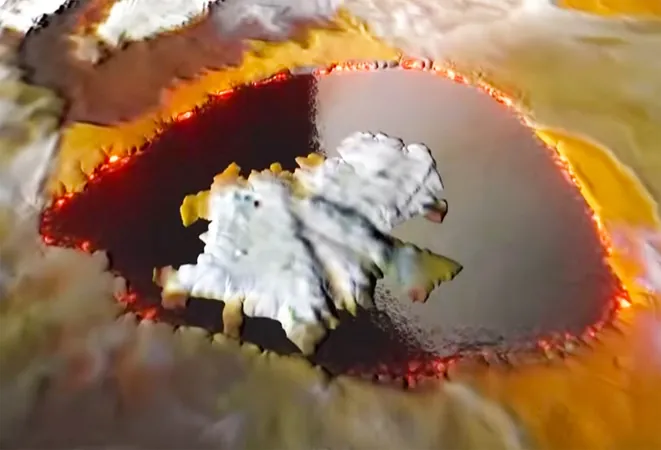
NASA Discovers 'Glass-Smooth Lake of Cooling Lava' on Jupiter's Fascinating Moon Io
2025-04-05
Author: Ken Lee
NASA Discovers 'Glass-Smooth Lake of Cooling Lava' on Jupiter's Fascinating Moon Io
In an exciting revelation, NASA researchers have unearthen a stunning feature on Io, one of Jupiter's most remarkable moons. Known for its extreme volcanic activity, Io boasts soaring lava lakes and explosive eruptions that propel sulfur and magma high into the sky, painting a mesmerizing yet hostile landscape.
Io: A Window into the Solar System's Secrets
Io is not just another moon; it is the most volcanically active body in our solar system. The gravitational pull from Jupiter and the gravitational tug from its neighboring moons create a dynamic that generates intense internal heat. This heat propels eruptions that can send volcanic material flying hundreds of miles away, contributing to Io's strikingly vibrant surface colors—bright yellows, reds, and whites from sulfur and volcanic flows.
However, despite its vivid appearance, Io is a harsh environment. It features a thin atmosphere that fails to provide protection from constant radiation, making it far from a candidate for hosting life as we know it.
Juno's Remarkable Insights
NASA's Juno spacecraft has been diligently studying Jupiter and its moons since its launch in 2011. Recently, two close flybys of Io provided unprecedented close-up images of the moon’s northern regions, allowing scientists to create animations that reveal the terrain's astonishing details, including a large lava lake known as Loki Patera.
Scott Bolton, the principal investigator of the Juno mission at the Southwest Research Institute, expressed his enthusiasm regarding these findings: “Io is simply littered with volcanoes, and we caught a few of them in action. We also got some great close-ups and other data on a 200-kilometer-long lava lake called Loki Patera.”
A 'Glass-Smooth' Surface
One of the most intriguing discoveries is a section of Io's landscape characterized by a "glass-smooth" appearance. The specular reflections observed by Juno indicate that certain areas of the moon's surface are as smooth as obsidian, hinting at rapid cooling processes that create this unique feature.
The islands found within the lava lake accentuate the ever-changing nature of Io's volcanic activity, exhibiting a mesmerizing contrast against the smooth terrain.
Io's Temperature Exploration
To probe further, Juno utilized its Microwave Radiometer (MWR) to measure temperature levels on Io, revealing that the poles are colder than the equatorial regions. This suggests that volcanic activity may be predominantly concentrated in the middle latitudes, providing new insights into the moon's thermal dynamics.
Glimpses of Jupiter's Enigmatic Polar Cyclones
In addition to studying Io, Juno continues to gather data on swirling polar cyclones at Jupiter's north pole. Steve Levin, Juno’s project scientist at NASA’s Jet Propulsion Laboratory, noted the distinct behaviors of these cyclones, particularly a prominent central cyclone that exhibits unique microwave signatures that differ from nearby storms.
Connecting the Dots on Jupiter's Water Content
A significant goal of Juno's mission is to uncover information about Jupiter's water content, which holds the key to understanding the planet's formation. Past data from the Galileo probe suggested anomalies in water distribution in Jupiter's atmosphere, leading scientists to question whether it sampled an unusually dry area.
However, new analysis from the MWR has provided clarity: Jupiter's equator contains water levels three to four times the solar abundance compared to hydrogen. This breakthrough reinforces the notion that water-ice material played a significant role during Jupiter's early formation.
What's Next for the Juno Mission?
As the Juno mission continues, researchers hope to compare water levels between Jupiter's polar areas and its equator, deepening our understanding of the planet's diluted core and its formation.
With each new finding, Juno enriches our understanding not only of Jupiter but also of its captivating moon, Io—a small yet powerful world that continues to astonish us with its otherworldly beauty.
For additional information on the Juno mission, visit [NASA's website](https://www.nasa.gov/juno) for ongoing updates and discoveries.


 Brasil (PT)
Brasil (PT)
 Canada (EN)
Canada (EN)
 Chile (ES)
Chile (ES)
 Česko (CS)
Česko (CS)
 대한민국 (KO)
대한민국 (KO)
 España (ES)
España (ES)
 France (FR)
France (FR)
 Hong Kong (EN)
Hong Kong (EN)
 Italia (IT)
Italia (IT)
 日本 (JA)
日本 (JA)
 Magyarország (HU)
Magyarország (HU)
 Norge (NO)
Norge (NO)
 Polska (PL)
Polska (PL)
 Schweiz (DE)
Schweiz (DE)
 Singapore (EN)
Singapore (EN)
 Sverige (SV)
Sverige (SV)
 Suomi (FI)
Suomi (FI)
 Türkiye (TR)
Türkiye (TR)
 الإمارات العربية المتحدة (AR)
الإمارات العربية المتحدة (AR)